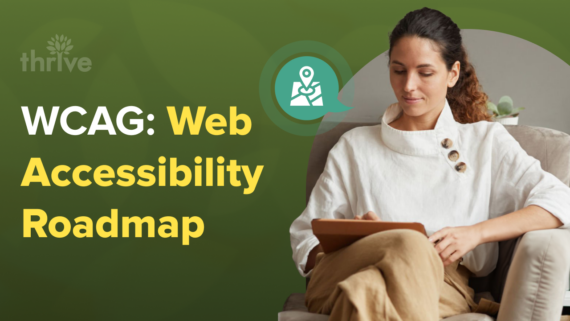Ensuring that websites are accessible to everyone, regardless of their abilities, is not just good practice – it’s a legal and ethical imperative. The Web Content Accessibility Guidelines (WCAG) provide a comprehensive framework for achieving this goal.
In this blog, we explore everything you need to know about accessible web design:
• Understanding Web Content Accessibility Guidelines (WCAG)
• The Four Principles of WCAG
• What Are WCAG Conformance Levels?
• What Is ADA Compliant Design?
• Why Do ADA and WCAG Matter?
• Tips for Implementing Web Accessibility Standards
Understanding Web Content Accessibility Guidelines (WCAG)
WCAG is a globally recognized set of standards created by the World Wide Web Consortium (W3C). It highlights various criteria that web developers and content creators can follow to ensure their content is more accessible to people with disabilities.
The Four Principles of WCAG
Let’s delve into the four principles of web content accessibility guidelines. What makes content WCAG-compliant?
1. Perceivable
This principle ensures that all information and site components can be perceived by users using one of their senses.
Imagine a webpage that includes a photograph of a city skyline at sunset. For users who are blind or visually impaired, the visual content of the photograph would be inaccessible without a text alternative.
2. Operable
Once visitors can perceive the content, they must be able to act on it. For example, individuals with learning disabilities may find mouse movements distracting or lack the hand-eye coordination required for precise mouse use. The operable principle ensures that all users can navigate and engage with content, regardless of their physical abilities or preferred input methods.
Operable Guidelines:
• Sufficient Time: Allow users adequate time to read and interact with content.
• Seizures and Physical Reactions: Avoid content design that may induce severe physical reactions.
• Navigable: Provide clear navigation aids to help users locate content and understand their location on the site.
• Input Modalities: Facilitate usability by supporting various input methods beyond keyboard interaction.
3. Understandable
Even if visitors can view and interact with content, a site is not fully accessible if users cannot comprehend it. Principle 3 ensures that visitors can understand the content fully to effectively engage with it. For instance, a page might feature:
• Unfamiliar words
• Confusing abbreviations
• Overly complex instructions
• Error messages that identify mistakes without offering guidance on how to rectify them.
• Interactive elements that seem familiar but behave unexpectedly
These factors emphasize the importance of clarity and coherence in presenting information. This consistency makes it easier for visitors to navigate web pages and complete transactions seamlessly.
For instance, a user with visual impairments may need to enlarge text on a website to read comfortably. This results in only a few words fitting on the screen at a time. This limited context makes it challenging for them to understand abbreviations and complete tasks efficiently, such as filling out forms or navigating through menus.
Principle 3 revolves around three key concepts:
A. Readable
Content must be readable by an educated person, with or without assistive technologies. Additional information necessary to understand the content must also be available. One of the simplest ways to enhance readability is by specifying the language(s) used on a web page.
B. Predictable
The site must behave in ways that people can predict. Web visitors not only look at text but also read patterns such as page layout, link organization and header style. These patterns guide users to locate information efficiently and navigate effectively. Consistent patterns aid in understanding content, while unpredictable ones increase the cognitive effort required and prolong the time users need to comprehend information.
C. Input Assistance
“Input assistance” in the context of WCAG 2.0 refers to strategies designed to prevent and correct mistakes, particularly when users interact with forms or input fields on websites.
Effective input assistance starts with providing clear instructions to users before they begin filling out forms. These instructions should outline how to complete fields correctly and what to expect upon submission. Offering users the opportunity to review and edit their entries before finalizing them enhances accuracy and reduces the likelihood of errors.
The importance of input assistance is amplified for individuals with disabilities, such as those with motor impairments or visual challenges. A person with a tremor, for instance, may unintentionally press keys, leading to input errors.
Similarly, someone who relies on speech recognition software may encounter discrepancies between dictated words and the actual input received by the system, requiring intuitive error correction mechanisms.
4. Robust
When building a web page, errors in the code are almost inevitable and can impact both its appearance and functionality. These errors may manifest in minor issues, such as slight formatting discrepancies, or major issues where the page fails to display altogether.
Principle 4 involves making a website robust, meaning it:
• Displays content exactly as intended by the author.
• Functions precisely as intended, ensuring all interactive elements and features work correctly.
• Maintains compatibility with current and future browsers, web-enabled device and assistive technologies.
The goal is to ensure your website endures technological advancements while remaining accessible for all users.
What Are WCAG Conformance Levels?
WCAG 2.1 includes three levels of conformance: Level A (the lowest), Level AA and Level AAA (the highest). Conformance at higher levels implies conformance at lower levels; for instance, meeting Level AA criteria also satisfies Level A requirements.
1. Level A – Basic Accessibility
Level A emphasizes fundamental web accessibility features. Meeting Level A criteria ensures that web content is accessible to certain users, though it may not fully accommodate all disabilities.
Level A includes 30 criteria. Examples of guidelines at this level include:
• Information or instructions should not rely solely on visual cues like shape, size or color.
• Forms must have clear labels or instructions to guide users.
• Non-text content such as images and videos must include text alternatives.
• Users must be able to navigate and interact with content using only a keyboard.
2. Level AA – Strong Accessibility
Level AA includes all Level A requirements and adds an additional 20 criteria. Examples include:
• Navigation elements across the site should maintain consistent design and functionality.
• Content should be structured with clear headings in a logical sequence, starting with H1, followed by H2, H3 and so on.
3. Level AAA – Excellent Accessibility
Level AAA criteria introduce an additional 28 requirements beyond Level AA. Examples include:
• Ensuring a contrast ratio of at least 7 to 1 between text and background.
• Providing sign language translations for pre-recorded video content.
• Offering extended audio descriptions for videos.
What Is ADA Compliant Design?
ADA compliant design ensures that websites and digital content meet the web accessibility standards outlined in the Americans with Disabilities Act (ADA), providing equal access and usability for persons with disabilities.
The U.S. Justice Department recommends using WCAG as a primary resource for achieving ADA compliance websites. Businesses open to the public and government agencies at state and local levels must comply with ADA regulations. Non-compliance can result in fines ranging from $55,000 to $150,000, as well as legal actions from affected users seeking accessibility.
Why Do ADA and WCAG Matter?
Individuals with disabilities may require additional time to complete tasks, whether it’s reacting physically, processing information or finding relevant details. Compliance with ADA marketing WCAG guidelines helps in removing barriers that could otherwise prevent these individuals from accessing and interacting with digital content effectively. This inclusivity not only supports legal requirements but also enhances user experience for all individuals, regardless of their abilities.
ADA compliance websites attract a broader audience, including those who rely on assistive technologies such as screen readers, keyboard navigation or voice recognition software.
At the same time, prioritizing ADA marketing shows a commitment to diversity, equity and inclusion. This resonates positively with customers and stakeholders, enhancing brand trust and loyalty.
Tips for Implementing Web Accessibility Standards
Follow these steps to integrate web content accessibility guidelines seamlessly into your design process:
• Conduct an Accessibility Audit: Scan your website for common accessibility issues like missing alternative text for images, improper heading structures or insufficient color contrast.
• Color Contrast and Fonts: Ensure that text maintains adequate color contrast with its background to ensure readability for users with low vision.
• Forms and Inputs: ADA websites include form fields with descriptive labels. Be sure to provide instructions and error messages that are clear and easy to understand. Validate input fields to assist users in entering information correctly.
• Text Alternatives: Ensure all non-text content such as images, videos and audio have appropriate text alternatives, captions or transcripts.
• Headings and Structure: ADA websites feature proper HTML heading tags (H1-H6) to organize content hierarchically. Headings should accurately describe the content that follows them, helping users navigate and understand the structure of your pages.
Achieve Accessible Design and Empower Users With Thrive
Web accessibility is an ongoing effort. At Thrive Internet Marketing Agency, we help you regularly monitor your website for accessibility issues and make necessary updates as technologies and guidelines evolve.
With our expertise in WordPress design and ADA compliance websites, we help you build a user-friendly platform that maximizes engagement and conversions. We can also determine your digital marketing health status and ensure your strategies align with current best practices.
Book a consultation now and amplify your online presence.








